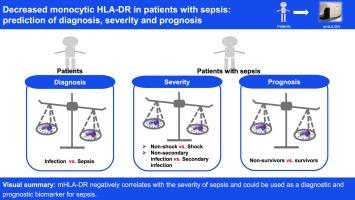Decreased monocytic HLA-DR in patients with sepsis: Prediction of diagnosis, severity and prognosis
IF 2.5
3区 医学
Q2 MEDICAL LABORATORY TECHNOLOGY
引用次数: 0
Abstract
Objective
Sepsis is characterized by high incidence and mortality rates, making early recognition and risk stratification critical for preventing delayed treatment and overtreatment. This study investigated the potential of monocytic (m) HLA-DR as a diagnostic and prognostic biomarker of sepsis.
Methods
In this prospective study, we collected blood in EDTA-anticoagulated tubes within 48 h from patients diagnosed with sepsis or infection and analyzed the percentage of mHLA-DR in peripheral blood mononuclear cells, C-reactive protein, and procalcitonin within 2 h of collection. We gathered clinical and laboratory data, including sex, age, and comorbidities, calculated the number of dysfunctional organs and sequential organ failure assessment (SOFA) score, and recorded the survival status of patients with sepsis on the 30th day after admission.
Results
mHLA-DR levels were lower in patients with sepsis (median 46.60 [interquartile range 23.86–66.51]%) than infection (75.44 [52.13–91.50]%). mHLA-DR could distinguish sepsis from infection with an area under the curve (AUC) of 0.724 (95 %CI 0.624–0.824). Decreased mHLA-DR levels have been found in septic patients with shock or secondary infections. mHLA-DR expression decreased with an increasing number of dysfunctional organs and higher SOFA score. In 30-day non-survivors, mHLA-DR levels were 26.94 (12.06–44.45)%, significantly lower than in survivors (55.20 [24.83–72.37]%). mHLA-DR predicted sepsis prognosis with an AUC of 0.750 (95 %CI 0.623–0.877). When the cut-off value was <52.29 %, the sensitivity and specificity of mHLA-DR for prognosis were 100 % and 52.83 %, respectively. The 30-day survival rate of septic patients with mHLA-DR ≥ 52.29 % was 6.798 (95 %CI 2.075–22.27) times higher than that of patients with mHLA-DR < 52.29 %.
Conclusion
mHLA-DR negatively correlates with the severity of sepsis and could be used as a diagnostic and prognostic biomarker for sepsis.

败血症患者单核细胞 HLA-DR 减少:预测诊断、严重程度和预后。
目的:败血症具有高发病率和高死亡率的特点,因此早期识别和风险分层对于防止延误治疗和过度治疗至关重要。本研究探讨了单核细胞(m)HLA-DR 作为败血症诊断和预后生物标志物的潜力:在这项前瞻性研究中,我们在 48 小时内用 EDTA 抗凝管采集了确诊为败血症或感染患者的血液,并在采集后 2 小时内分析了外周血单核细胞中 mHLA-DR 的百分比、C 反应蛋白和降钙素原。我们收集了包括性别、年龄和合并症在内的临床和实验室数据,计算了功能障碍器官的数量和序贯器官衰竭评估(SOFA)评分,并记录了脓毒症患者入院后第 30 天的生存状况。结果:与感染(75.44 [52.13-91.50] %)相比,脓毒症患者的 mHLA-DR 水平较低(中位数 46.60 [四分位距 23.86-66.51]%)。随着功能障碍器官数量的增加和 SOFA 评分的提高,mHLA-DR 的表达也会降低。在 30 天内未存活的患者中,mHLA-DR 水平为 26.94 (12.06-44.45)%,明显低于存活者(55.20 [24.83-72.37]%)。mHLA-DR 预测脓毒症预后的 AUC 为 0.750 (95 %CI 0.623-0.877)。结论:mHLA-DR与脓毒症的严重程度呈负相关,可用作脓毒症的诊断和预后生物标志物。
本文章由计算机程序翻译,如有差异,请以英文原文为准。
求助全文
约1分钟内获得全文
求助全文
来源期刊

Clinical biochemistry
医学-医学实验技术
CiteScore
5.10
自引率
0.00%
发文量
151
审稿时长
25 days
期刊介绍:
Clinical Biochemistry publishes articles relating to clinical chemistry, molecular biology and genetics, therapeutic drug monitoring and toxicology, laboratory immunology and laboratory medicine in general, with the focus on analytical and clinical investigation of laboratory tests in humans used for diagnosis, prognosis, treatment and therapy, and monitoring of disease.
 求助内容:
求助内容: 应助结果提醒方式:
应助结果提醒方式:


